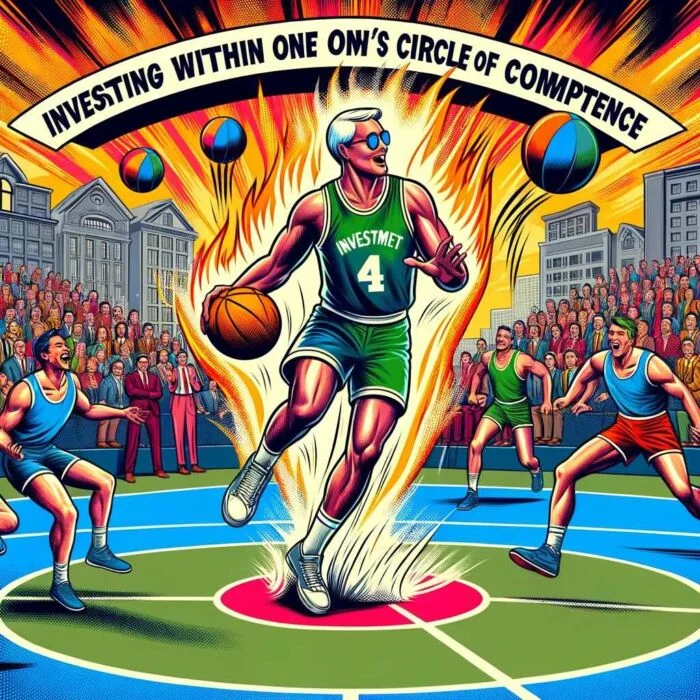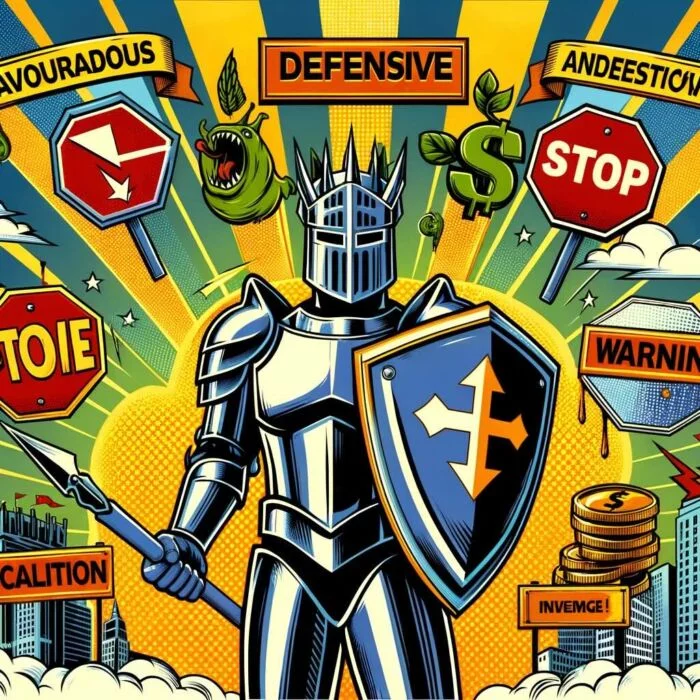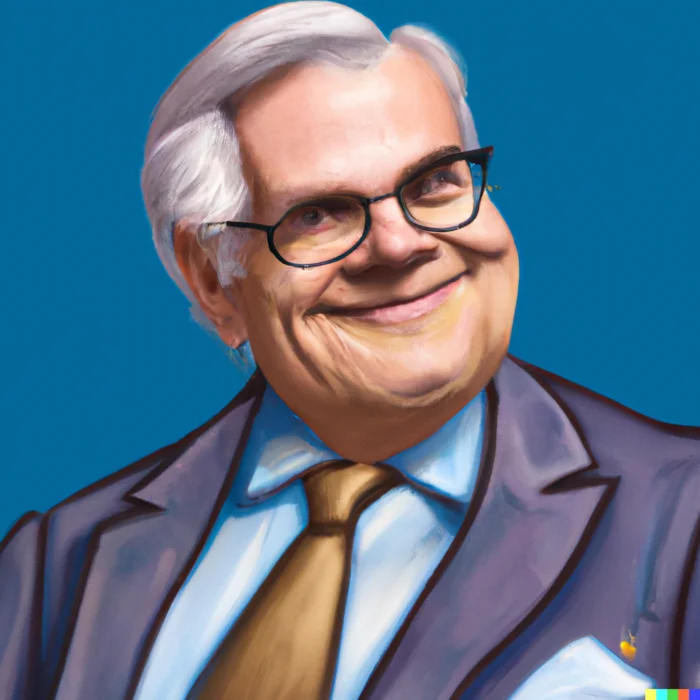Dubbed the “Oracle of Omaha”, Warren Buffett’s name has become synonymous with value investing. Born in 1930, Buffett honed his skills under the tutelage of Benjamin Graham, the father of value investing, at Columbia Business School. The investing philosophy of Buffett can be seen as a refined version of Graham’s ideas, with a dash of patience, discipline, and an unerring faith in the power of compounding.

At its core, Buffett’s investment philosophy revolves around the concept of investing in businesses rather than merely trading stocks. His primary objective is to acquire substantial ownership in quality businesses, which he defines as those with excellent management, enduring competitive advantages, and the capacity to generate high returns on capital.

Buffett’s philosophy focuses on the long-term, embodying an extreme level of patience and foresight. He is known to famously quip, “Our favorite holding period is forever.” His belief in holding investments over the long haul allows companies ample time to grow and compound returns.
Further, Buffett emphasizes the importance of investing within one’s Circle of Competence, only making moves when the odds are heavily in favor and when the price is right. It’s all about understanding the game thoroughly before you step into it – which leads us to the second part of our discussion.

Introduction to Warren Buffet’s Concept of the Circle of Competence
In the world of investing, jargon can often create an illusion of complexity, when in fact the underlying concepts are beautifully simple. One such concept, heavily endorsed by Warren Buffett, is the “Circle of Competence.” This elegant principle, in its essence, means understanding your areas of expertise and sticking to them while making investment decisions.
Picture a circle. Inside this circle lies your knowledge, skills, and expertise – it’s where you are the master of the domain. This is your Circle of Competence. You know the ins and outs, the nuances, the nitty-gritty. It could be a particular industry, a particular type of investment, or even a geographical location. Outside this circle lies the unknown, the areas where you are not well-versed.
Buffett’s endorsement of this concept is rooted in humility and prudence. He understands that no one can know everything and that the financial world is rife with intricacies and uncertainties. By defining his Circle of Competence, Buffett ensures that he only invests in businesses he thoroughly understands. This practice helps him avoid missteps, reduce errors, and make more informed decisions.

When you invest within your Circle of Competence, you’re playing a game where you’re the expert. You’re on home turf. You understand the game better than most. This not only increases your chances of success, but also reduces the likelihood of catastrophic failures.
This concept may sound simplistic, but it demands constant learning and self-awareness. It requires one to continuously reassess and expand their circle without overstepping its boundaries. It’s a delicate balancing act between knowing what you know and recognizing what you don’t.
Remember, Buffett himself admitted that he doesn’t understand the business models of many tech companies and thus largely steers clear of them. The Oracle of Omaha reminds us, “It’s not important how large your circle is; what is paramount is staying within its bounds.
Warren Buffett’s philosophy of investing and his concept of the Circle of Competence invite us to embark on a journey of knowing our strengths, accepting our limitations, and making smart, informed investment decisions. It encourages us to turn inwards, explore our capabilities, and then use that knowledge to navigate the vast, exciting world of investing.
source: Progress Leaves Clues on YouTube
Understanding the Circle of Competence

To truly understand the essence of the Circle of Competence, let’s examine its two key components: the circle and the competence.
Imagine a circle. This circle is not just a geometric shape, but a symbolic representation of the sphere of your understanding and knowledge. It encompasses everything that you’re proficient in, all that you understand deeply and intuitively. This circle does not limit you but rather defines your mastery, the arena in which you can make well-informed decisions.
Now, onto competence. Competence here refers to your level of understanding, expertise, and skill. It is not simply about knowledge, but rather a deep comprehension that enables you to make accurate predictions, identify opportunities, and avoid pitfalls. Competence also includes the ability to continue learning and expanding your knowledge within this defined sphere.
Putting these together, the Circle of Competence is the zone in which your knowledge, skills, and experience converge, creating a powerful tool for making informed investment decisions.

Warren Buffett’s Belief in Focusing on What You Understand
Warren Buffett is not just an investing titan, but also a keen advocate of self-awareness and humility in investing. He believes that understanding your Circle of Competence is not a luxury but a necessity. By investing in industries and companies within your circle, you capitalize on your strengths and avoid the pitfalls of venturing into the unknown.
Buffett’s wisdom in this regard is refreshingly clear: “Stick to what you know.” In his view, the world of investing doesn’t reward knowledge of everything, but mastery of something. This isn’t about being a jack-of-all-trades, but rather about being a master of one – or a few.
This philosophy is not about limitation but about concentration. It’s about sharpening your focus and leveraging your expertise to its fullest extent. If you can be an expert in a few things, rather than a novice in many, you’re likely to have a substantial edge in investing.

The Importance of Self-Awareness in Investing
Just as a mirror reflects our image, self-awareness reflects our competencies and our limits. It forces us to confront our strengths and weaknesses, our knowledge and ignorance. In the world of investing, this self-awareness is of paramount importance.
Understanding your Circle of Competence demands a high degree of self-awareness. It requires an honest and critical evaluation of what you know and what you don’t. It’s about being realistic about your understanding and capabilities, and not overreaching in an attempt to grasp the ungraspable.
Investing without self-awareness is akin to wandering in a dense forest without a map. It’s easy to get lost, to make poor decisions, to fall into traps. But with self-awareness, you have a compass. You know where you are, where you should go, and perhaps most importantly, where you shouldn’t.
Understanding your Circle of Competence doesn’t mean you should stop learning or expanding your knowledge. Quite the contrary! It encourages constant learning and growth within your defined sphere. By strengthening and expanding your Circle of Competence, you become a more capable and confident investor.
In the grand arena of investing, self-awareness helps you stay grounded. It keeps your feet firmly planted in the soil of your competence while allowing your ambitions to reach for the skies. As we navigate through the exciting yet often intimidating world of investing, let’s remember Warren Buffett’s wisdom – the importance of knowing what we know, the courage to admit what we don’t, and the wisdom to differentiate between the two.
source: Value Investors Archive on YouTube
Identifying Your Circle of Competence
Embarking on the journey to identify your Circle of Competence begins with a comprehensive self-assessment of your knowledge, skills, and experience. It’s time to dive deep and introspect, to sift through the sands of your understanding to find nuggets of wisdom.
To begin, make a list of industries or sectors that you have a deep knowledge of. Perhaps you’ve spent years working in the healthcare sector and have a thorough understanding of its ins and outs. Maybe you’re an IT professional who can easily grasp the intricacies of software companies. Or perhaps you’re an avid reader with a passion for publishing companies.
Next, identify the skills you possess that give you an edge. Do you have a knack for analyzing financial statements? Are you good at identifying trends and patterns in market data? Or perhaps you’re an expert at understanding and assessing management teams? These are all skills that can give you an advantage in investing.
Lastly, take into account your experience. Experience, as they say, is the best teacher. You might have industry-specific knowledge that only comes from years of hands-on experience. Maybe you’ve been investing for a decade and have a good sense of market cycles. Or perhaps you’ve been through a market crash and learned invaluable lessons that can only come from such an event.
Determining Industries and Sectors Within Your Expertise
Once you’ve thoroughly assessed your knowledge, skills, and experience, it’s time to apply this understanding to the world of investing. This is where you determine which industries and sectors fall within your Circle of Competence.
This is not just about understanding an industry’s basics, but about having a profound and comprehensive understanding of its landscape, trends, key players, and potential disruptors. It’s about being able to foresee where this industry might be headed and what influences could drive its future.
Keep in mind, this doesn’t mean you need to stick to one single sector. Your Circle of Competence could span multiple sectors, as long as you’re confident about your comprehensive understanding in each of them.

Recognizing the Limits of Your Circle of Competence
This may well be the most critical part of defining your Circle of Competence – acknowledging its boundaries. Remember, recognizing the limits of what you know is a sign of wisdom, not weakness.
You might find it challenging, especially when the boundaries of your Circle of Competence keep you from investing in the hottest stocks or the latest tech revolution. However, as Buffett has repeatedly emphasized, it’s safer and more profitable in the long run to admit your limitations rather than overstep them.
One of the most challenging aspects of investing is managing the Fear of Missing Out (FOMO). But, if a particular sector or industry lies outside your Circle of Competence, it’s wise to resist the temptation. After all, investing in what you thoroughly understand provides a protective moat against the volatile waves of the market.
Identifying your Circle of Competence is a journey of self-discovery, a process of understanding yourself better as an investor. It’s about turning the mirror towards yourself and honestly evaluating your strengths and weaknesses. And in this reflection, you can find a path that not only leads to better investing but also a deeper understanding of yourself. As the ancient Greek aphorism goes, “Know thyself,” and your investments may just thank you for it!

Benefits of the Circle of Competence
Investing is as much about the mind as it is about money. Confidence in your decisions is crucial in navigating the choppy waters of the financial markets. Understanding your Circle of Competence equips you with a sense of self-assurance, allowing you to stand firm in the face of market fluctuations and avoid knee-jerk reactions.
Operating within your Circle of Competence provides an intrinsic shield against unnecessary risks. You’re not shooting in the dark, nor are you relying on mere hope or hype. You’re investing based on knowledge, insight, and comprehension. It’s akin to playing a game where you’ve mastered the rules, know the playing field, and can anticipate the moves of your opponents. Consequently, your investments are likely to be less volatile and more robust, thereby reducing the overall risk in your portfolio.
Ability to Make Informed Investment Decisions
Just as a well-tuned instrument produces harmonious music, a well-informed investor makes wise investment decisions. Knowledge is power, and in the world of investing, it is indeed profitable. Operating within your Circle of Competence equips you with the information and understanding needed to identify attractive investment opportunities and to steer clear of potential investment traps.
Being well-versed in a specific industry allows you to interpret news, developments, and trends more accurately, giving you a strategic advantage. You can understand the nuances that others may miss and can predict potential impacts that others may overlook.
Investing is not about guessing the future, but about making educated assumptions based on sound reasoning. And the Circle of Competence provides you with the solid foundation necessary for these deductions.

Avoiding Costly Mistakes and Preserving Capital
As Warren Buffett’s mentor, Benjamin Graham, famously said, “The first rule of investment is ‘don’t lose money.’ And the second rule of investment is ‘don’t forget the first rule.'” Keeping this mantra in mind, one of the most significant benefits of the Circle of Competence is its role in preserving your capital by helping you avoid costly blunders.
Venturing outside your Circle of Competence is like wandering into uncharted territory without a map. The chances of making a wrong turn or stumbling into a pitfall increase substantially. On the other hand, by investing within your Circle of Competence, you’re far less likely to fall prey to investment fads or be lured into seemingly attractive but fundamentally flawed investments.
Preserving capital is a vital aspect of investing, often overlooked in the pursuit of high returns. However, as Buffett and other successful investors have shown, protecting your downside is often the first step towards achieving sustainable, long-term investment success.
In conclusion, the Circle of Competence serves as a compass in your investment journey, guiding you towards the shores of informed decisions, preserving your capital, and fostering investment confidence. It’s a powerful tool, a trusted ally, and a silent mentor. By understanding and honoring your Circle of Competence, you are not just following the path of one of the greatest investors of our time, but also paving your own way towards investment success.
source: Adam J. Mead – The Oracle’s Classroom on YouTube
Expanding Your Circle of Competence

Your Circle of Competence is not set in stone; it is more like an organic entity that can grow and evolve over time. This growth, however, is not automatic. It requires dedication, effort, and an unquenchable thirst for knowledge.
Constant learning is the oxygen that fuels the expansion of your Circle of Competence. This involves staying abreast of current trends and developments, and continuously updating your knowledge. It means becoming a lifelong learner who sees every day as an opportunity to learn something new.
Remember, knowledge in the investing world isn’t just about understanding different sectors and industries. It also encompasses understanding the broader economic landscape, financial concepts, and market dynamics. Reading widely, attending seminars, taking online courses, or even going back to school are all effective ways to enhance your knowledge and broaden your Circle of Competence.
Researching and Studying New Industries
Another effective way to expand your Circle of Competence is by delving into new industries. Start by exploring sectors that are adjacent or related to those you already understand. Since these areas are likely to have overlaps with your existing knowledge, it might be easier to grasp their nuances.
Researching a new industry should be approached with the curiosity of a detective and the diligence of a scholar. Read industry reports, follow industry news, understand the key players, analyze the competition, learn about the challenges and opportunities, and study the trends and innovations.
While this process can be time-consuming and even overwhelming, it’s a journey of discovery that can potentially unveil lucrative investment opportunities. Remember, every industry was once foreign to you until you learned about it.
Seeking Guidance from Experts and Mentors
Learning doesn’t always have to be a solitary pursuit. In fact, seeking guidance from experts and mentors can significantly expedite the process of expanding your Circle of Competence. The wisdom of those who have walked the path before you can provide invaluable insights and save you from potential pitfalls.
Reach out to industry experts, join investment clubs, attend investment conferences, or find a mentor. These resources can provide you with insights that you might not find in books or reports. Furthermore, discussions with these individuals can challenge your ideas, refine your understanding, and expose you to different perspectives.
Warren Buffett himself has often acknowledged the influence of his mentors, notably Benjamin Graham, on his investing journey. As he once said, “It’s better to hang out with people better than you. Pick out associates whose behavior is better than yours, and you’ll drift in that direction.”
Expanding your Circle of Competence is a proactive and continuous process of learning, exploring, and seeking guidance. It’s a journey that demands effort, curiosity, and humility. But it’s a journey well worth undertaking. After all, as the Roman philosopher Seneca once said, “As long as you live, keep learning how to live.” And perhaps we can add, “As long as you invest, keep learning how to invest.”

Case Studies: Applying the Circle of Competence
Warren Buffett’s investment portfolio provides us with several illuminating examples of successful investments made within his Circle of Competence. Let’s consider two notable instances: Coca-Cola and GEICO.
Examples of Successful Investments Within Buffett’s Circle of Competence
- Coca-Cola: Buffett first invested in Coca-Cola in 1988, a time when the company was suffering from a temporary setback. However, Buffett had a profound understanding of the brand value, customer loyalty, and the simplicity of the beverage industry. He understood that despite the hiccup, Coca-Cola’s strong global brand and its timeless appeal to consumers would help it bounce back. More than three decades later, Coca-Cola remains one of the flagship investments of Berkshire Hathaway, delivering consistent returns.
- GEICO: The story of GEICO is particularly intriguing. Buffett first encountered the company in his early 20s when he was a student of Benjamin Graham. Upon learning that Graham was the chairman of GEICO, Buffett took a train to Washington D.C. and showed up unannounced at GEICO’s headquarters on a Saturday, only to find the building closed except for a single employee – Lorimer Davidson, who explained the insurance business to young Buffett. This meeting, and Buffett’s subsequent understanding of the insurance sector, eventually led to Berkshire Hathaway’s complete acquisition of GEICO in 1996. GEICO’s success is a testament to Buffett’s deep understanding of the insurance industry, a sector firmly within his Circle of Competence.

Lessons Learned from Investments Outside the Circle of Competence
Just as success teaches us lessons, so do failures. Buffett, despite his legendary status, is no exception and has had his share of missteps when venturing outside his Circle of Competence.
- Dexter Shoe Company: In 1993, Buffett acquired the Dexter Shoe Company, believing it had a durable competitive advantage. However, over the years, Dexter Shoe could not compete against cheaper imports, and the business quickly deteriorated. Buffett, who paid for Dexter in Berkshire stock, called this a “$3.5 billion blunder,” admitting that he failed to appreciate the vulnerability of the shoe industry to foreign competition.
- Technology Stocks: Buffett has traditionally shied away from the technology sector, acknowledging that it was outside his Circle of Competence. However, during the Dot-Com boom of the late ’90s, even he felt the market pressure. He invested in a company called USAir, lured by its lucrative dividends but overlooking the complexities of the airline industry and the company’s heavy debt load. Eventually, the investment resulted in significant losses for Berkshire Hathaway.
Warren Buffett’s investment journey provides invaluable lessons about the power and importance of the Circle of Competence. His successes highlight how investing within this circle can lead to consistent and long-term returns. In contrast, his missteps serve as stark reminders of the risks involved in venturing outside this circle. As we navigate our own investment journeys, these case studies can serve as guiding lights, reminding us of the wisdom of investing within our Circle of Competence.
source: Yahoo Finance on YouTube
Challenges and Limitations of the Circle of Competence
Investing within your Circle of Competence can sometimes lead to an investment portfolio that’s overly specialized. While specialization has its merits, it’s essential to remember that diversification is a fundamental risk management strategy in investing.
Balancing Specialization with Diversification
The challenge, then, lies in maintaining that delicate balance between being a specialist and not having all your eggs in one basket. It’s like trying to stand on a seesaw – lean too much on one side, and you risk losing your footing.
On one hand, you want to invest in areas you understand deeply. On the other hand, you also want to spread your risks across different sectors and asset classes. Striking this balance is not always straightforward and often requires a nuanced understanding of both your Circle of Competence and the broader investment landscape.

Adapting to Evolving Industries and Technological Advancements
We live in an age of rapid change, where today’s cutting-edge technology can become tomorrow’s ancient history. In such a dynamic environment, one of the significant challenges is ensuring your Circle of Competence evolves and keeps pace with these changes.
Just as a plant needs constant nurturing to grow, your Circle of Competence needs regular feeding with updated knowledge. What was once a profitable industry may decline, and new industries you’ve never heard of may arise. If your Circle of Competence remains static in this dynamic world, it could end up being a circle of obsolescence.
It’s essential, therefore, to keep your finger on the pulse of the industry you specialize in, continuously learn, and be willing to adapt your Circle of Competence as needed. As Darwin observed, “It is not the strongest of the species that survives, nor the most intelligent; it is the one most adaptable to change.”
Recognizing When to Seek Expertise Beyond Your Circle of Competence
Just as crucial as recognizing the boundaries of your Circle of Competence is acknowledging when you need to bring in expertise from outside it. There might be situations where you find a potentially attractive investment opportunity, but it lies outside your area of expertise.
In such situations, it’s crucial to know when to tap into the knowledge of others who understand that area better. This could be through consultation with industry experts, hiring a specialized financial advisor, or investing in a sector-specific fund managed by a professional.
However, it’s important to note that while others’ expertise can be an invaluable supplement to your own, it should not substitute your due diligence. You should still strive to understand, at least at a high level, why the investment makes sense.
In conclusion, while the Circle of Competence is a powerful guiding principle in investing, it does come with its own set of challenges and limitations. Navigating these successfully requires a careful balance between specialization and diversification, a willingness to learn and adapt, and the humility to seek outside expertise when needed. But as with any journey, facing these challenges head-on can make the rewards all the sweeter!

12-Question FAQ: Inside Warren Buffett’s Circle of Competence
What does “Circle of Competence” actually mean?
It’s the set of domains where your understanding is deep enough to make informed, repeatable decisions. Inside the circle you can explain business models, drivers, risks, and valuation with clarity; outside it, you defer, learn, or pass.
Did Buffett invent the idea?
He popularized it and turned it into a practical discipline, building on Graham’s emphasis on knowing what you’re buying. Buffett’s twist is ruthless self-awareness: the size of your circle matters less than knowing its edges.
How do I map my own circle?
Do a knowledge audit: list industries you can explain to a curious teenager, key unit economics, 3–5 value drivers, leading risks, and two credible bear cases. If you can’t do that from memory (then verify with research), it’s likely outside.
What are signs I’m outside my circle?
You’re leaning on buzzwords, can’t model how cash becomes free cash flow, can’t identify competitors’ moats, or feel FOMO more than conviction. If you need “someone else must have checked this” to feel safe, that’s a red flag.
How does the circle reduce risk?
Staying inside cuts unforced errors: you avoid misreading incentives, overpaying for stories, or confusing cyclical winds for moats. It also improves position sizing because your estimates and ranges are better calibrated.
Can my circle be small and still work?
Absolutely. A narrow, well-defended circle with disciplined “no”s can outperform a sprawling, shallow one. Depth beats breadth if you demand margin of safety and only swing at fat pitches.
What’s a practical test for competence?
Use a 5-point scorecard for any prospect: (1) unit economics clarity, (2) moat durability, (3) management incentives, (4) key risks with leading indicators, (5) valuation with explicit base/bull/bear. If any score ≤2, pass or keep studying.
How do I expand the circle without drifting?
Grow adjacently. If you know beverages, study snacks or distribution; if you know P&C insurance, study reinsurance. Read 10-Ks back ten years, industry primers, and transcripts; build tiny “tuition” positions only after you can teach the topic.
What role do case studies play?
They anchor judgment. Buffett’s wins (e.g., simple, brand-driven consumer staples; understandable insurers) and misses (e.g., misjudged import competition, cyclical traps) illustrate how alignment with—or drift from—the circle maps to outcomes.
How does this tie to portfolio construction?
Inside the circle → larger, longer-held positions. At the edge → smaller starters with strict review gates. Outside → no position. The circle is your sizing and holding-period policy, not just your watchlist.
How do I handle fast-changing tech fields?
Treat pace of change as a risk factor. If core economics and competitive dynamics mutate faster than you can maintain mastery, either keep it outside or partner with specialists (funds, co-investors) while keeping your own diligence bar high.
What are good “tripwires” to protect the circle?
Pre-commit rules: no thesis without a one-page model; no purchase without two disconfirming checks; automatic re-review if a leading KPI breaks trend; and a written “why we’re qualified” paragraph for each holding.
Conclusion: Circle of Competence Concept
Our journey through the Circle of Competence has taken us through the wisdom-filled corridors of Warren Buffett’s investment philosophy. As a compass guiding our investment decisions, the Circle of Competence provides us with a conceptual framework that encourages us to operate within our realm of understanding. By recognizing the confines of our knowledge and expertise, we stand a much better chance of steering our ship successfully through the turbulent waters of the financial market.
Importance of Staying Within Your Area of Expertise
One cannot overstate the importance of staying within one’s area of expertise when it comes to investing. It’s the bedrock upon which the entire edifice of your investment portfolio is built. Straying outside this sphere is akin to venturing into a thick forest without a map – the chances of losing your way are high, and the cost can be devastating.
In contrast, investing within your Circle of Competence provides you with a clearer understanding of the investment landscape, reduces unnecessary risks, helps you make informed decisions, and prevents costly mistakes. It’s a protective moat that guards your investment castle against the potential onslaught of market volatility.

Practical Application of the Circle of Competence in Investing
As we conclude this exploration of the Circle of Competence, let’s remember that investing is not just a game of numbers, but also a game of wisdom. And wisdom often lies not in knowing a lot, but in recognizing what you don’t know.
It’s also essential to remember that your Circle of Competence is a dynamic entity. As you continue to learn, explore, and gain new experiences, this circle can expand, opening up new vistas of investment opportunities. But as it expands, ensure that it deepens too. Depth of understanding is just as, if not more, important than breadth.
Lastly, remember that the Circle of Competence, like any other tool, is most effective when used judiciously. It’s a guide, not a gospel. It’s a torch that can illuminate your path, but it’s up to you to walk that path.
As Warren Buffett once said, “Risk comes from not knowing what you’re doing.” So, as we set forth in our investment journey, let’s strive to know what we’re doing. Let’s invest not just our money, but also our time and effort, into understanding our Circle of Competence. For it’s in this understanding that we might find our most profitable investment yet.
Important Information
Comprehensive Investment Disclaimer:
All content provided on this website (including but not limited to portfolio ideas, fund analyses, investment strategies, commentary on market conditions, and discussions regarding leverage) is strictly for educational, informational, and illustrative purposes only. The information does not constitute financial, investment, tax, accounting, or legal advice. Opinions, strategies, and ideas presented herein represent personal perspectives, are based on independent research and publicly available information, and do not necessarily reflect the views or official positions of any third-party organizations, institutions, or affiliates.
Investing in financial markets inherently carries substantial risks, including but not limited to market volatility, economic uncertainties, geopolitical developments, and liquidity risks. You must be fully aware that there is always the potential for partial or total loss of your principal investment. Additionally, the use of leverage or leveraged financial products significantly increases risk exposure by amplifying both potential gains and potential losses, and thus is not appropriate or advisable for all investors. Using leverage may result in losing more than your initial invested capital, incurring margin calls, experiencing substantial interest costs, or suffering severe financial distress.
Past performance indicators, including historical data, backtesting results, and hypothetical scenarios, should never be viewed as guarantees or reliable predictions of future performance. Any examples provided are purely hypothetical and intended only for illustration purposes. Performance benchmarks, such as market indexes mentioned on this site, are theoretical and are not directly investable. While diligent efforts are made to provide accurate and current information, “Picture Perfect Portfolios” does not warrant, represent, or guarantee the accuracy, completeness, or timeliness of any information provided. Errors, inaccuracies, or outdated information may exist.
Users of this website are strongly encouraged to independently verify all information, conduct comprehensive research and due diligence, and engage with qualified financial, investment, tax, or legal professionals before making any investment or financial decisions. The responsibility for making informed investment decisions rests entirely with the individual. “Picture Perfect Portfolios” explicitly disclaims all liability for any direct, indirect, incidental, special, consequential, or other losses or damages incurred, financial or otherwise, arising out of reliance upon, or use of, any content or information presented on this website.
By accessing, reading, and utilizing the content on this website, you expressly acknowledge, understand, accept, and agree to abide by these terms and conditions. Please consult the full and detailed disclaimer available elsewhere on this website for further clarification and additional important disclosures. Read the complete disclaimer here.





